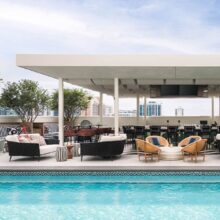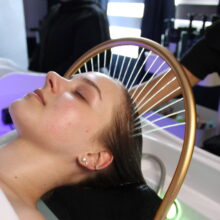2012 Spa Trends Revisited: Wellness and Beauty Coaching (gets an “A”)
- Published: Tuesday, November 20th 2012
- in Living Well
The Coaching Trend was one we predicted for our top 10 spa trend list for 2012 and indeed it turned out to be a big one.
In fact, I just received an email from my colleague Kathryn Stolle referencing that trend and I thought you might enjoy some of what she said. Here is her introduction (you can read the rest in the comment after this blog post):
“Ideas can be life changing – we all know that. But sometimes an idea or concept can have a profound impact on not just a single life, but in a chain reaction, on a number of lives. A year ago, Susie Ellis’ 2012 Spa Trends introduced a concept/trend that would change my life forever: wellness coaching.”
So if I was to grade us on how we did on this trend prediction….I will take a modest “A”.
“Health coaching,” “wellness coaching,” even “eyebrow coaching” — coaching is a concept gathering steam at spas, with new approaches ranging from the very serious…to the simply engaging and fun.
First, the serious: While “coaching” seems to be a term that can get wantonly slapped onto any professional or personal goal, the concept is especially applicable and packed with potential for the spa sector.
Integrative medicine leader Dr. Ken Pelletier recently noted that the spa industry is actually in a better position (than the medical establishment) to deliver preventative “healthcare,” i.e., to provide an environment and offerings that can actually help people make long-lasting lifestyle changes — the number-one medically proven path to disease prevention and optimal health.
But to fill those large (and potentially profitable) shoes, more spas must “switch” their model from delivering isolated treatments and establish more personal, post-visit connections with clients that could actually help sustain the changes — i.e., “coaching.”
“Wellness coaching” and “health coaching” are, therefore, very serious trends (rather than faddish new marketing terms), and some very high-level institutions are validating that position.
Harvard Medical School (www.harvardcoaching.org) now underwrites an annual conference on coaching’s role in healthcare, while supporting the Institute of Coaching.
And one of the many research initiatives being analyzed by the International Coaching Research Forum is developing coaching as a global, academic profession.
There are already efforts underway to clearly define the parameters of coaching and help distinguish coaching (which is future-focused) from other professional services like counseling (which delve into a person’s past).
Corporations are digesting the power and ROI of coaching: Those ramping up investments in corporate wellness programs, to reduce their crushing healthcare costs, are reporting that wellness coaching is the most effective model to get people to adhere, long-term, to healthy regimes.
Destination spas are taking the lead with both at-the-spa “coaching” models and post-stay coaching connections.
For instance, Arizona’s Mii amo (U.S.) spa resort recently integrated coaching, and its “guided journey packages” include follow-up with a guest’s onsite coach.
Arizona’s Miraval Resort & Spa (U.S.) “Integrative Wellness Program” offers ongoing, back-home wellness consultations, and San Francisco’s Cavallo Point (U.S.) offers diverse forms of “Life Enhancement Coaching,” where guests can opt for unlimited follow-up sessions.
Canyon Ranch health resorts’ (two U.S. locations) “Follow Up at Home” program involves 30- to 50-minute phone, email and Skype sessions with a whole host of practitioners: doctors, nutritionists, “life management therapists,” even Traditional Chinese Medicine experts and spiritual counselors.
And Rancho La Puerta (Mexico) has teamed up with technology company, SelfOptima (creators of the www.spaevidence.com website), to adopt its brand-new “WellO” guest engagement platform (featuring health assessments, progress charting, ways to stay in touch with the spa’s experts and peer social networking) designed to keep people connected to both the spa, after departure, and to their health regime.
More “coaches” of diverse stripes, and more coaching language (i.e., “fitness coach,” not “trainer,” etc.), will invade both day and resort spas, as these sectors realize the model’s unique power in keeping customers ultra-close, engaged and spending.
And coaching is now hitting the beauty arena, too.
Spa skincare brand Skin Authority represents an early pioneer of the concept of after-spa follow-up with online aestheticians. French beauty brand Clarins recently opened its new Parisian flagship, Spa My Blend, and its therapists are now called “beauty coaches,” who “provide support for people to reveal their own essential beauty.” (The brand’s spa also has “pool coaches” for customized aquatic activities, and fitness specialists known as “body coaches.”
Prediction: The big, breakthrough opportunities still lie ahead, as professional “coaching networks” are just getting organized. When this becomes widespread, every type of spa would then be able to enlist coaches, train them in its unique philosophies and have them serve as the critical link between the on-site spa experience and its clients’ long-term wellness success. Companies like Wellpeople.com (U.S.) already offer certified on-site or virtual wellness coaches for spas, hospitals and businesses. Australian-based The Cosgrove Group, which has offered wellness coaching-certification programs at home and in Europe for a few years, just launched in the U.S., and expects to certify 1,000 American wellness coaches this year. This is all very new, right about where the fitness industry was 30 years ago, and efforts to establish “certification” models will continue to develop.
Look for: greater specialization in coaching approaches (i.e., “states of change,” “mindfulness,” “wellness wheel,” etc.), and for ever-expanding coaching categories, i.e., “nutrition coaches,” “sleep coaches,” etc. New models like group coaching and shorter-term, follow-up coaching will emerge, so that a coaching program of some variety could be within the reach of day spas, hotel/resort spas and more destination spas — and to more people, given the greater range of price-points.
The coaching trend is a serious and welcome one for the global spa industry, and could ultimately prove the key to making the spa that true “third place” (like Starbucks) for so many more people.



